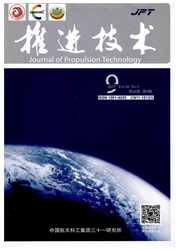

 中文摘要:
中文摘要:
为了解决跨声速串列转子的低裕度问题,就必须了解跨声速串列转子的流场结构与失速机制.设计了叶尖切线速度为450m/s,负荷系数为0.56的高负荷跨声速串列转子.基于数值模拟的结果,分析了该串列转子在0.5mm叶尖间隙下的叶尖流场结构与失速机制,并在此基础上分别探讨了叶尖间隙和前、后排叶片周向位置对串列转子特性的影响和失速机制的变化.结果表明:前排叶片的叶尖区域是影响串列转子稳定性的关键;随着叶尖间隙的增加,串列转子的失速机制也发生变化,从前排叶片叶尖区域的尾迹与径向潜流堵塞后排叶片通道转变为前排叶片叶尖泄漏流堵塞;在较大周向相对位置(后排叶片压力面周向远离前排吸力面)的情况下,串列转子获得最好的效果,随着周向相对位置(PP)的增加,失速部位从后排叶片转移至前排叶片.
 英文摘要:
英文摘要:
In order to enhance the stall margin of transonic tandem rotor, a better un- derstanding about its flow structure and stall mechanism is required. Thus, a highqoaded transonic tandem rotor was designed to perform a loading coefficient of 0. 56 at tip tangent speed of 450m/s. Based on the simulation results, firstly, the tip flow field and stall mecha- nism of this tandem rotor with the shroud gap of 0.5 mm was analyzed, and then the influ- ence of different tip clearances and percent pitch values on stall mechanism was studied. It is indicated that the tip area of forward blade plays a prominent role in the stability of transonic tandem rotor. Along with the increase of tip clearance, the stall mechanism of tandem rotor also changes from the stagnation of aft blade tip area caused by wake and subsurface flow to the blocking of forward blade tip area caused by the tip leakage flow. The tandem rotor will achieve its best effect under high percent pitch (PP) value, and the stall onset position will move from the aft blade towards the forward blade with the increase of percent pitch.
 同期刊论文项目
同期刊论文项目
 同项目期刊论文
同项目期刊论文
 期刊信息
期刊信息
